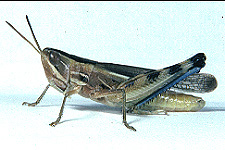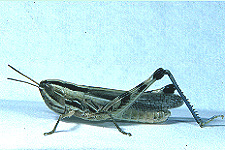Grasshoppers of Wyoming and the West
Entomology
Amphitornus coloradus (Thomas)
 |
 |
| Adult male | Adult female |
Common name - striped slant-faced grasshopper (Helfer, 1972).
Geographic distribution - occurs from British Columbia (Canada), Washington, Oregon and California east to Manitoba, Minnesota, Illinois, Iowa, Kansas, Oklahoma and Texas (Brooks, 1958; Otte, 1981). In Colorado it inhabits the plains and mountain valleys of the eastern and western parts of the state (Hebard, 1929).
Habitat - dry grassy slopes and small, grassy spots, especially along river valleys (Blatchley, 1920; Brooks, 1958; Gillette, 1904).
Food habits - graminivorous and prefers needlegrasses, threeawn, Sandberg bluegrass, beardgrass, grama grasses, wheatgrass and brome (Anderson, 1964; Brooks, 1958; Hewitt, 1977; Kumar et al., 1976; Mulkern et al., 1964).
Eggs - egg pods are small, each one containing four whitish eggs. Average egg length, 5 mm; average diameter, 1.1 mm (Onsager and Mulkern, 1963).
Nymph - five instars (Putnam, 1962).
Adult - medium size. General color is brownish-yellow with two brown stripes running from
the top of the head, broadening and fading toward the tip of the tegmina. Face is
slightly slanted back. Antennae are slender. Dorsal posterior margin of pronotum is
rounded. Median carina of pronotum is distinct; lateral carinae indistinct. Tegmina
are unspotted with a whitish line on the basal third. Wings are clear. Hind femora
are banded with black on the upper and inner faces. Knees are black. Hind tibiae are
bluish. Male length, 20 mm; female, 25 mm (Brooks, 1958; Hantsbarger, 1979; McNeill,
1896).
Adult females are inactive most of the time and stay on one plant. Males are more
active and move from plant to plant (Anderson and Wright, 1952).
Oviposition - eggs are laid in the crowns of grasses, especially needleandthread grass (Pfadt, 1972).
Seasonal history - eggs overwinter and hatch at the end of May. First instars can be seen until the middle of June. Adults can be found from late June to early October (Mulkern et al., 1964; Newton et al., 1954; Pfadt, 1972).
Abundance and importance - very common throughout eastern Colorado (Gillette, 1904). It can cause heavy losses on the native grasslands (Blatchley, 1920).
Next Species: Anabrus simplex
Previous Species: Ageneotettix deorum
Biology of Common Colorado Grasshoppers List
Biology of Common Colorado Grasshoppers
Grasshoppers of Colorado Contents

